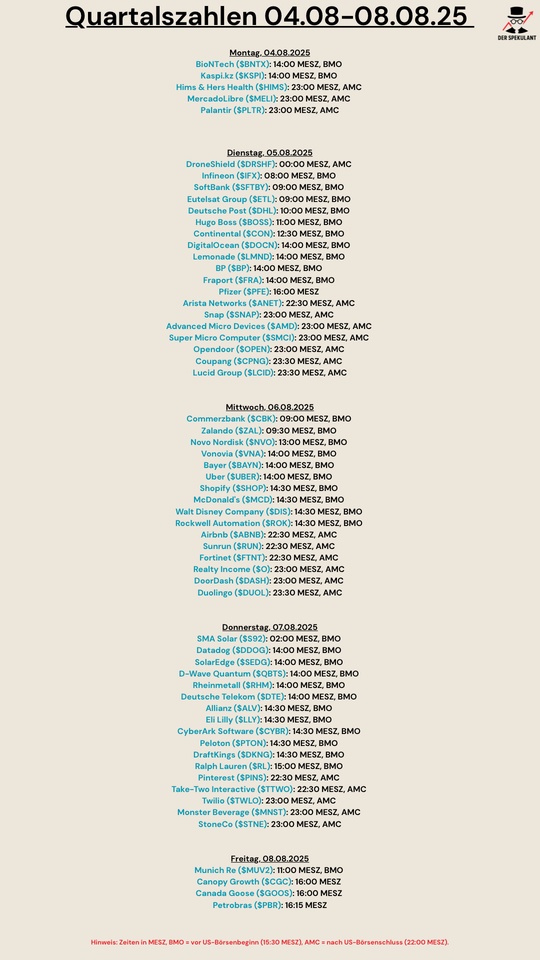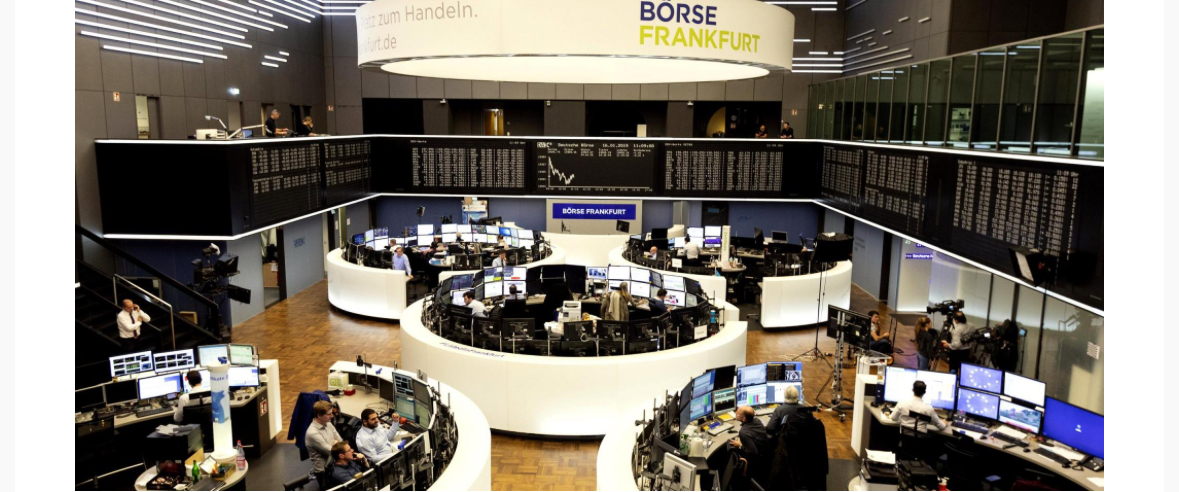As the share performed very well, it has now become my largest position. I am therefore now taking some profits. 300 shares remain in the portfolio.
Unfortunately, around € 1200 of this will be lost in taxes.

Messaggi
60$BNTX (+0,76%)
$ON (+0,32%)
$HIMS (-2,08%)
$PLTR (+2,29%)
$O (+0,85%)
$8058 (-0,49%)
$7974 (-3,26%)
$BP. (-2,9%)
$BOSS (+0,43%)
$SWK (-0,21%)
$SPOT (+0,81%)
$N1CL34
$UBER (+0,46%)
$CPRI (-2,59%)
$SHOP (-0,85%)
$RACE (-0,31%)
$HOG (-1,52%)
$HTZ (-0,9%)
$PFIZER
$UPST (-0,87%)
$ANET (+0,07%)
$PINS
$TEM (+0,38%)
$AMD (+0,85%)
$SMCI (+2,06%)
$RIVN (-0,32%)
$BYND (-1,87%)
$KTOS (-1,47%)
$CPNG (+0,34%)
$BMW (+3,77%)
$NOVO B (+0,63%)
$FRE (-0,62%)
$ORSTED (+1,57%)
$AG1 (-0,17%)
$EVT (-1,76%)
$CCO (-3,13%)
$DOCN (+5,1%)
$LMND (+3,25%)
$SONO (+1,83%)
$MCD (+1,17%)
$HOOD (-3,49%)
$QCOM (+0,46%)
$FTNT (+2,15%)
$FSLY (-9,04%)
$HUBS (+0,77%)
$ELF (-1,44%)
$ARM (+0,66%)
$SNAP (+1,95%)
$DASH (+1,59%)
$APP (+1,36%)
$AMC (-2,5%)
$ZIP (+1,1%)
$FIG (-2,1%)
$LCID (-4,94%)
$DUOL
$UN0 (+0,22%)
$CBK (+0,13%)
$DEZ (+1,39%)
$ZAL (+0,76%)
$HEN (-0,08%)
$MAERSK A (-0,59%)
$HEI (+0,9%)
$CON (-0,34%)
$AZN (+0,18%)
$ALB (+5,95%)
$MRNA (+8,19%)
$QBTS (-5,37%)
$WBD (+6,34%)
$LI (+0%)
$RHM (+0,26%)
$DDOG (-0,78%)
$RL (+3,63%)
$OPEN (-5,31%)
$ABNB (+2,65%)
$PTON (-2,12%)
$MP (+1,13%)
$TTD (+2,05%)
$STNE (-6,66%)
$SQ (-1,56%)
$GRND (-1,7%)
$IREN (-3,25%)
$AFRM (-1,31%)
$CRISP (+0%)
$RUN (-3,3%)
$7011 (+2,36%)
$DTG (+0,04%)
$HAG (-0,69%)
$DKNG (-3,04%)
$LAC (-2,14%)
$KKR (+0,98%)
$PETR3 (-2,32%)
$CEG
$WEED (-4,81%)

The German stock market was weak on Tuesday. Pressure was exerted on the indices not least by weak US stock markets, following the absence of trading in the USA on Monday due to Labor Day. The Dax slipped more sharply below the psychologically important 24,000-point mark, which has come back into focus since last week.
"Recently, buyers have always entered the market at the 24,000-point threshold," commented portfolio manager Thomas Altmann from QC Partners. "However, it is quite conceivable that this buying threshold will gradually shift downwards."
At lunchtime, the leading German index was down 1.1 percent at 23,784 points. The MDax fell below 30,000 points. Most recently, the index of medium-sized companies lost 1.8 percent to 29,914 points.
With regard to the USA, the main focus is on the reaction of the US stock markets after an appeals court denied President Donald Trump the authority to impose far-reaching tariffs on imported products on Friday, citing an emergency law.
"In Asian trade, the continuing uncertainty about the economic impact of the US punitive tariffs was used for profit-taking," said market expert Andreas Lipkow. In view of the power struggle taking place behind the scenes around the US Federal Reserve, there are currently many questions and the upcoming meeting in September is the subject of much discussion.
"An interest rate cut is far from a foregone conclusion." The upcoming economic data from the US, such as the labor market report on Friday, is therefore likely to play an important role. "Many new risk clusters are currently forming, which could still cause considerable fluctuations on the financial markets."
Among the individual stocks in the Dax, the FMC-Aktie ($FMC (-0,87%) ) brought up the rear, losing 4.9 percent. A sell recommendation from the major Swiss bank UBS weighed on the stock. Analyst Graham Doyle referred to structural risks with regard to business development in the USA and the danger of falling consensus estimates for the operating result.
Siemens ($SIE (+1,15%) ) fell by 2.8 percent. They suffered from a downgrade to "market perform" by Bernstein Research. Analyst Nicholas Green justified his move with the strong share price gains in recent years. Commerzbank ($CBK (+0,13%) ) , downgraded to "Equal-weight" by Morgan Stanley, lost 2.4 percent. At the current valuation level, analyst Alvaro Serrano wrote that further progress in the Frankfurt-based company's business plan is needed first.
In the SDax the share price of SMA Solar ($S92 (-3,7%) ) fell by 28 percent. The manufacturer of inverters for photovoltaic systems lowered its forecast for the current year and now expects an operating loss. The restructuring efforts that have already been initiated are to be intensified further.
The fact that the motor manufacturer Deutz ($DEZ (+1,39%) ) is expanding its still small business in the defense market with the planned acquisition of the Sobek Group. The share gained 6.0 percent at the top of the index. The Sobek Group is a drive specialist for drones.
It's been over a year since my last presentation.
I have continued to pursue my goal of reducing individual stocks during this time. 🎯 I have now reached a point where I am saving a single ETF ( $VWRL (+0,32%) ) with €1,500/month and let all other securities continue to run. 📈
Buying individual stocks has become rather rare for me. However, one of these was a good buy last year: $CBK (+0,13%) with a current +120% 🚀as well as $MUX (+0,72%) which I sold at +33% (a little too late). My 12 Krugerrands also did quite well with an annual performance of around 31%. 🏅
I'm currently holding some cash for a good opportunity. 💶
I am happy about any feedback on my portfolio 🥳
$BNTX (+0,76%)
$KSPI (-1,06%)
$HIMS (-2,08%)
$MELI (-3,29%)
$PLTR (+2,29%)
$DRO (-0,91%)
$IFX (+2,96%)
$9434 (-1,83%)
$FR0010108928
$DHL (-0,36%)
$BOSS (+0,43%)
$CONTININS
$DOCN (+5,1%)
$LMND (+3,25%)
$BP. (-2,9%)
$FRA (-0,03%)
$PFIZER
$SNAP (+1,95%)
$AMD (+0,85%)
$SMCI (+2,06%)
$OPEN (-5,31%)
$CPNG (+0,34%)
$LCID (-4,94%)
$CBK (+0,13%)
$ZAL (+0,76%)
$NOVO B (+0,63%)
$VNA (-0,18%)
$BAYN (-0,58%)
$UBER (+0,46%)
$SHOP (-0,85%)
$MCD (+1,17%)
$DIS (-0,28%)
$ROK (-0,3%)
$ABNB (+2,65%)
$RUN (-3,3%)
$FTNT (+2,15%)
$O (+0,85%)
$DASH (+1,59%)
$DUOL
$S92 (-3,7%)
$DDOG (-0,78%)
$SEDG (-7,36%)
$QBTS (-5,37%)
$RHM (+0,26%)
$DTE (+0,29%)
$ALV (+0,18%)
$LLY (-0,33%)
$CYBR (+1,68%)
$PTON (-2,12%)
$DKNG (-3,04%)
$RL (+3,63%)
$PINS
$TTWO (+0,02%)
$TWLO (+1,46%)
$MNST (+0,16%)
$STNE (-6,66%)
$MUV2 (-0,58%)
$WEED (-4,81%)
$GOOS (-4,17%)
$PETR3T
$ANET (+0,07%)

Bayer surprises with stable quarterly figures
At Bayer $BAYN (-0,58%) the first quarter of 2023 did not quite go according to plan, but the decline in earnings was milder than many analysts had feared. The company's pharmaceuticals division proved particularly robust and posted a positive performance despite the uncertainties caused by US tariff policy. The adjusted operating result amounted to just under 4.1 billion euros, which was more than seven percent below the previous year, but did not completely disappoint the expectations of market observers. CEO Bill Anderson was optimistic and emphasized that the possible dampening effects of higher US import tariffs should not cloud the overall outlook. On a positive note, the forecast for the pharmaceuticals business was raised, even if the customs issue remains an issue. Investors on the stock market were delighted, with Bayer shares rising by eleven percent at times, catapulting the company to become the biggest winner in the DAX. Despite challenges in the agricultural sector, Bayer maintained consolidated sales at the previous year's level of 13.7 billion euros. Nevertheless, the company continues to face legal costs running into the billions, particularly as a result of the glyphosate lawsuits in the USA.
Commerzbank focuses on socially responsible job cuts
In Germany, Commerzbank has $CBK (+0,13%) has taken a significant step towards increasing efficiency together with the works council. Around 3900 jobs are to be cut by 2028, 3000 of which will be affected as part of the "Momentum" savings and investment program. The bank has set itself the goal of making this process socially responsible. Regulations such as partial retirement, early retirement and severance payments will be used. Sabine Mlnarsky, Chief Human Resources Officer, explained that these measures are necessary in order to achieve the goals of the program in Germany in the long term. Further details on the job cuts are to be published by October. Commerzbank has set itself ambitious targets in order to maintain its independence in the face of pressure from Italy's Unicredit. While the number of employees in Germany is falling, the bank plans to keep the total number of employees stable worldwide.
Sources:
https://www.n-tv.de/wirtschaft/Commerzbank-zurrt-Plan-fuer-Stellenabbau-fest-article25768871.html
The German bank has now also used the coalition agreement and the associated special fund as the basis for a list of recommendations.
The result is a list of 10 potential profiteers.
The result:
$CBK (+0,13%) - Commerzbank
$ENR (+0,49%) - Siemens Energy
$VOS (+2,27%) - Vossloh
$HEI (+0,9%) - Heidelberg Materials
$EVK (+0,94%) - Evonik
$KGX (-1,51%) - Kion
$BC8 (-1,23%) - Bechtle
$COK (+2,47%) - Cancom
$VOW (+1,13%) - Volkswagen
$PAL (+1,37%) - Palfinger
Source: "Welt"

I migliori creatori della settimana